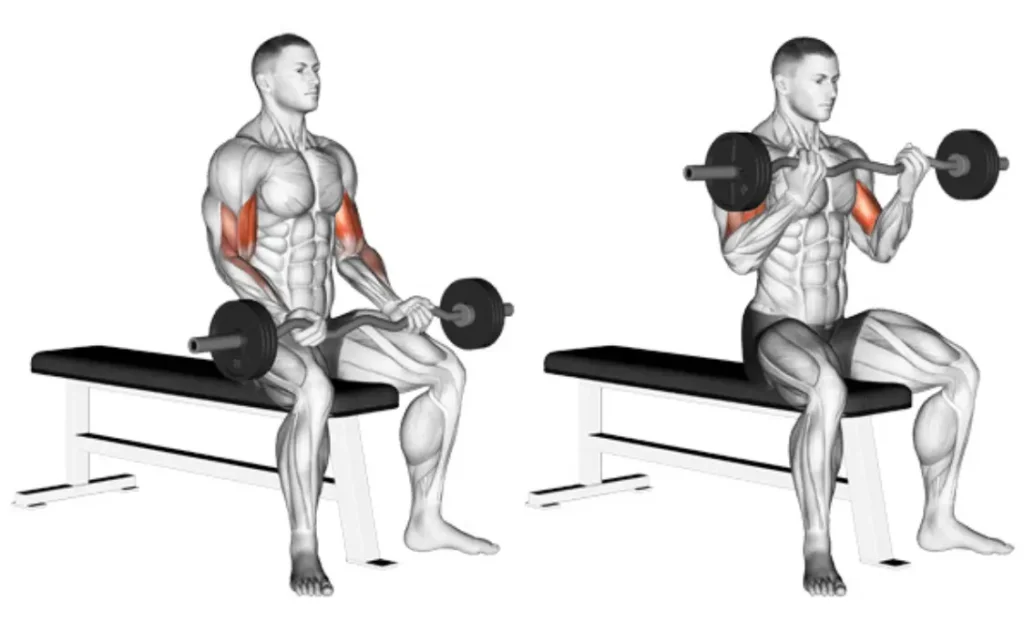Building strong biceps requires exercises that deeply activate the muscles.
The seated barbell curl can do the job by giving your biceps the necessary workout.
Performing a seated curl is not that complicated if you once read the instructions, and you do not need a fancy machine to perform this exercise either.
By following the guide we went through, you can execute this exercise properly and get all the benefits it offers.
Benefits of the Seated Barbell Curl
Just like every other curl, the seated curl holds some hidden gems within it.
Can Be Done With Minimal Effort
The seated barbell curl offers the benefit of a fixed 90-degree angle for both the upward and downward phases of the movement, reducing the overall exertion required.
Additionally, being seated during the exercise further minimizes strain.
While some may assume that this variation might not yield as much bicep definition as other variations, it’s crucial to recognize its suitability, particularly for beginners.
May Help to Improve Posture
Our daily habits, such as lounging in comfy chairs at work or relaxing on the couch at home, often take a toll on our posture without us even realizing it.
This might not seem like a big deal, but in the long run, it could really be a troublemaker.
But exercises like seated barbell curls can be excellent choices to help you fix your sitting posture.
You have to maintain your back straight throughout the entire movement, which can train your brain to stay straight when you are seated.

How to Do Seated Barbell Curl
- Position yourself on a flat bench with the barbell placed close to your waist. Maintain a natural and straight sitting posture.
- Grab the barbell with shoulder-width apart palms facing up.
- To start, curl the bar up while your elbows stay close to your body. Pause for a second to squeeze the biceps.
- Now return to the starting position, maintaining proper form and control throughout.
Equipment: Standard Barbell, Bench
Primary Muscle Work: Short Head (Biceps Brachii)
Grip: Shoulder Width Apart (supinated grip)
Seated Barbell Curl Tips
- Full Range of Motion: Despite the seated position’s limitations, aim for a full range of motion. Lower the bar until your elbows extend fully, then curl it upward until your forearms approach your biceps. This maximizes bicep engagement within the exercise’s constraints.
- Avoid Excessive Weight: Choose a weight that allows you to perform the exercise with proper form and technique. Using too much weight can lead to cheating and compromise the effectiveness of the exercise.
Common Mistakes
They say exercise can either break you or build you up. Here are three common mistakes to watch out for:
Improper Barbell Placement
The barbell should be placed close to your waist, not in the middle.
If you place the bar in the middle of your lap, the exercise will be less effective, and you might have a chance of getting injured.
Lifting from the middle may cause your elbows to be pulled forward, placing undue pressure on them during the top phase of the movement and potentially damaging the joints.
Not Using Proper Form
This is a common mistake for many exercises, and the seated barbell curl is no exception.
The seated barbell curl is executed while seated, and because of that, many of us had a hard time keeping our backs straight. This issue may stem from our daily habits, such as sitting in comfortable chairs for extended periods, which can result in poor spinal posture.
But you can address this through stretching exercises and by consciously focusing on maintaining proper back alignment during the exercise.
Overlooking the Negative Phase
Some lifters only focus on the lifting phase, which is important since the biceps bear most of the tension at that phase, but the lowering phase is just as important as the lifting phase.
The downward movement plays a role in targeting your biceps from angles, enhancing the overall effectiveness of your workout.
Therefore, lowering the barbell is beneficial to slow down and maintain control during the descent to ensure full activation of your biceps throughout the entire motion range.
Alternatives and Variation
Seated Dumbbell Curl
An effective variation is to target both heads of the biceps brachii and achieve defined arm muscles.
This exercise involves curling one dumbbell at a time while seated, allowing for more independent movement of each arm.
This promotes balanced muscle growth and enhances overall arm symmetry.
Concentration Curl
One can’t overlook the concentration curl when discussing seated curling exercise alternatives.
Why? Because the way it activates your biceps is simply remarkable.
All you need is a flat bench and a barbell to perform this exercise. Sit on the bench, slightly lean forward, and curl the barbell with proper form.
Preacher Curl
The seated preacher curl offers numerous advantages for working your arm muscles effectively.
With the preacher bench supporting your armpits, you can comfortably execute the exercise with proper form.
The muscle work for the preacher curl is similar to the seated curl, but you can target different muscle groups with adjustments to the bench and grip.
Start Building
Seated barbell curls can be an effective exercise for your arm muscles.
Many new lifters might get on the wrong path when executing this exercise. But everyone can learn if they are willing to put in some time and practice.
Featured Image Credit Bodybuilding.com/YouTube